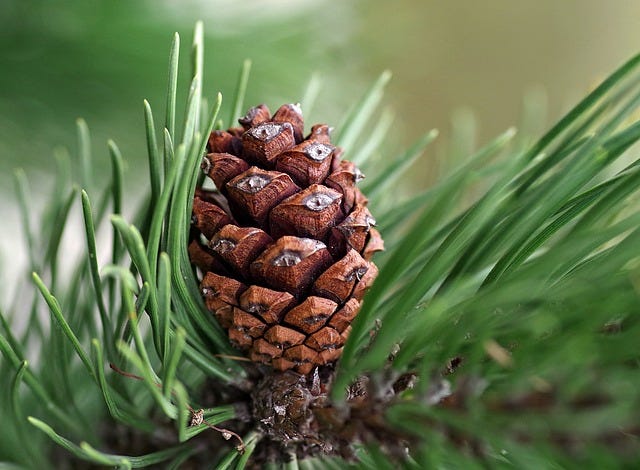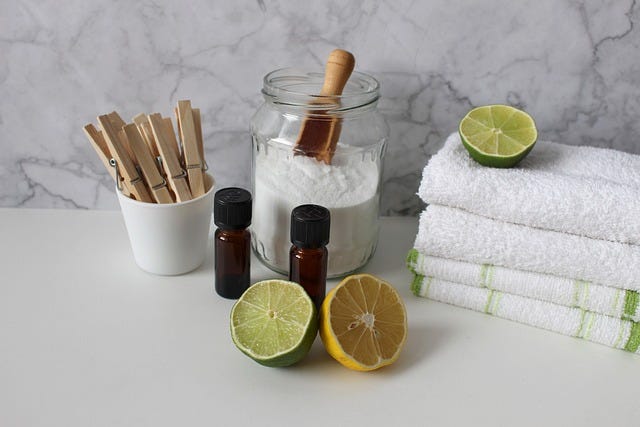Spruce essential oil: properties and application. The school of natural cosmetics. Lesson 30
The aroma of spruce oil not only relaxes and soothes, but also protects against viruses and bacteria, helps with diseases, cares for skin and hair.
The essential oil of spruce has a multicomponent composition.
Most of all there are monoterpenes (such as limonene, beta-fellandrene, camphene, alpha-pinene) – these are what we hear in the tart, camphor aroma. They have antiseptic properties, anti-inflammatory, lymphatic drainage and analgesic effects.
(1) - “Contrary to common opinion, limited EOs possess demonstrated potential as antimicrobial agents. It should be emphasized that although the antimicrobial activity is well established, the real effect is significantly weaker compared to synthetic compounds (including antibiotics). Gram-positive bacteria seem to be much more susceptible to essential oil than Gram-negative organisms. According to available data, the activity is usually correlated with phenolic, aromatic, or alcohol groups. Due to their high volatility, the effective time of action is limited, and features such as encapsulation could be changed. On the other hand, low toxicity level, as well as their natural origin, makes them an attractive alternative in both the food as well as in cosmetic industries. Several practical application could be implemented in these industries. In summary, it should be underlined that the use of EO in microbial stabilization is possible, but all cases must be individually examined.”
Also in the composition:
esters (bornyl acetate with a relaxing effect on the nervous system),
sesquiterpenes (including beta-caryophyllene – with strong analgesic and anti-stress effects),
monoterpene alcohols (borneol and linalool).
Such a rich and complex composition gives us a number of advantages at once:
1. It is more difficult for bacteria to adapt and develop resistance to multicomponent mixtures (unlike conventional antiseptics based on a single active ingredient).
2. An integrated approach: for example, in case of injury, we will simultaneously have the necessary anti-inflammatory, decongestant and analgesic effects.
3. Softness is when the action of more active components, aggressive in isolated form, is smoothed out by soft ones.
Properties of spruce essential oil
Fir essential oil has bactericidal, anti-inflammatory, antiseptic, antiviral, soothing, wound healing, toning and rejuvenating effects.
The use of this product has a positive effect on the psycho-emotional state of a person. Therefore, the use of spruce oil is advisable for depression, bad mood, irritability, apathy. This is an excellent tool for raising vitality.
1. It has an antibacterial effect on a number of gram-positive bacteria.
This property is useful to us in the treatment of infections – from colds to skin inflammations.
2. Antifungal effect on Candida.
Candida is a kind of yeast that causes thrush, dermatitis, digestive disorders, etc. It helps to cope with dandruff.
3. Lymphatic drainage effect.
Spruce oil can drive away swelling, has an expectorant effect. It is useful for coughs, runny nose, puffiness and even cellulite.
4. Anti-inflammatory effect.
Relieves inflammation in case of injuries, bruises, chronic joint diseases, helps with arthritis, sciatica. It is also effective against acne, inflammation of the skin, mucous membrane (oral cavity).
5.Antispasmodic.
Relieves muscle spasms, relaxes the body and relieves pain.
6. Stimulates blood circulation.
Fir essential oil gives a light warming effect, tones up, and is ideal for preparing muscles for sports. Improves the flow of nutrients to the hair follicles.
7. Anti-stress effect.
Relieves stress, tension, fatigue, weakened state after illness. It supports the nervous system, promotes easy falling asleep in the evening.
Why use spruce essential oil in cosmetology?
In cosmetology, spruce oil is valued as an antioxidant, antibacterial, anti-inflammatory and tonic.
1.It is an essential oil for problematic, oily and age-related facial skin, infections and inflammations.
2. Suitable for the body: tones, relieves tension, smoothes the appearance of cellulite.
3. Spruce oil is often used for scalp problems: it improves hair growth and protects against dandruff.
Spruce essential oil in its pure form is not used for the skin, but it can be added to face masks and creams (only in special cream cosmetic bases), used for massage.
Anti-aging serum
This oil serum contains everything you need for age-related skin. Vegetable oils are selected taking into account the fatty acid composition: in the proportion in which they are necessary for the healthy functioning of the skin.
1. Lemongrass and pumpkin essential oil stimulate collagen synthesis, smoothing wrinkles.
2. Vitamin E, essential oil of spruce, black currant and grapes saturate the skin with antioxidants, as well as relieve inflammation and prolong youth.
3. Macadamia oil contains a rare palmitoleic acid, which is necessary to maintain elasticity (with age, its natural production in the skin decreases, and additional nutrition is needed).
Ingredients:
Argan oil 2 teaspoons
Macadamia oil 1 teaspoon
Pumpkin oil 1/2 teaspoon
Jojoba oil 1/2 teaspoon
Blackcurrant oil 8 drops
Grape seed oil 5 drops
Vitamin E (complex) 3 drops
Spruce essential oil 2 drops
Lemongrass essential oil 2 drops
Instruction:
Combine vitamin E and essential oils, add base oils alternately and mix everything thoroughly. That's it! You and I have a saturated serum in 5 minutes of cooking.
Let the mixture brew and use 2-3 drops in the morning and evening. Apply to your fingers and pat over cleansed face skin. Apply your cream on top.
For hair
Fir essential oil is very useful for hair and scalp. It is used in the fight against dandruff, hypersecretion of sebaceous glands and loss of curls. Masks based on coniferous essence strengthen the hair follicle and fight fungal diseases of the dermis.
After applying the oil, the hair becomes smooth, elastic and fragrant. The appearance of dandruff is significantly reduced (up to complete disappearance),
Hair growth mask
The vegetable base of coconut, macadamia and jojoba nourishes the hair along its entire length, improves its structure, increases smoothness and hydration. Immediately after applying the mask, you will be surprised how much better the hair looks, and after about 3-4 weeks you will find that the curls began to grow faster.
Ingredients:
Coconut oil 1 tablespoon
Macadamia oil 1 tablespoon
Jojoba oil 1/2 tablespoon
Natural emollient 1 tablespoon
CO2 extract of birch leaves 1 teaspoon
Spruce essential oil 14 drops
Laurel essential oil 6 drops
Instruction:
1. Mix the essential and birch extract, add vegetable oils and natural emollient (it is needed to lighten the mixture a little, improve its distribution and flushing).
2. If the coconut oil is frozen, just warm it a little in a jar under a stream of hot water.
3. Mix and pour into a clean bottle.
4. Apply the mixture to the roots of the hair, and then along the length of the hair, distributing it with a comb.
5. Wrap up your hair: the perfect combination is a shower cap + a warm hat.
6. Hold for an hour and rinse with shampoo (it will take 2 applications, first the shampoo is distributed over the head and hair, then water is added).
7. Dry your hair, ideally without a hair dryer under a towel.
8. Use a course of care 2 times a week.
The use and benefits of spruce oil for the body
Relaxing and restorative body massage is performed with fir essential oil. It is included in the composition of mixtures to combat cellulite, scars, scars and stretch marks.
In its pure form and with other oils, it fights foot sweating, corns and calluses. It is also used as an auxiliary component for the treatment of rashes, dermatitis and the elimination of the consequences of injuries.
Aromatherapy with fir essential oil
Aromatherapy helps a person to restore their health in a short time after suffering from illnesses. The product increases the protective functions of the body, and also contributes to the normalization of metabolism. It is effective to use aromatherapy with essential oil of spruce in the fight against infectious diseases with the help of hot inhalations. It is no less effective for the treatment of bronchitis.
The smell of spruce has a stimulating and antidepressant effect. Ether helps to cope with life difficulties more easily, adapt to the situation, reduce nervous tension and clarify consciousness.
The essence is added to aroma lamps and diffusers. A few drops can be added to a personal aroma bottle to stabilize the emotional state. Before taking water treatments with oil, it is pre-recommended to dissolve it in a teaspoon of honey or drop 4-5 drops on a handful of sea salt.
(2) - “Aromatic scents and oils used in clinical aromatherapy can be beneficial for symptom management such as pain, nausea, vomiting, anxiety, depression, stress, insomnia, agitation with dementia, cancer pain, and end of life symptoms, Clinical aromatherapy has been found beneficial in the inpatient and outpatient settings especially critical care, oncology, palliative care, hospice, and surgical. On the flip side, aromatic essential oils can be dangerous and toxic due to certain oils being flammable, causing skin dermatitis, or being phototoxic, with risks of chemical burn, oral toxicity, and even death. Therefore, it is important that nurses learn about essential oils. If a facility has a clinical aromatherapy program, it is critical that frontline nurses be educated with a classroom course on essential oils. Champions need to be selected for a clinical aromatherapy practitioner course. These certified aromatherapists can lead the program, serve as consultants, and mentor nurses.”
Before use, be sure to consult your doctor and perform a preliminary sensitivity test. Apply a few drops of ether to your wrist or the crook of your elbow and observe the reaction.
(1) - The National Library of Medicine(USA); Essential Oils as Antimicrobial Agents—Myth or Real Alternative? Katarzyna Wińska, Wanda Mączka, Jacek Łyczko, Małgorzata Grabarczyk, Anna Czubaszek, and Antoni Szumny; Published online 2019 Jun 5. https://www.ncbi.nlm.nih.gov/pmc/articles/PMC6612361/
(2) - The National Library of Medicine(USA); Clinical Aromatherapy; Ashley J. Farrar, BSN, RNa and Francisca C. Farrar, EdD, MSN, RNb; Published online 2020 Sep 28.
https://www.ncbi.nlm.nih.gov/pmc/articles/PMC7520654/









